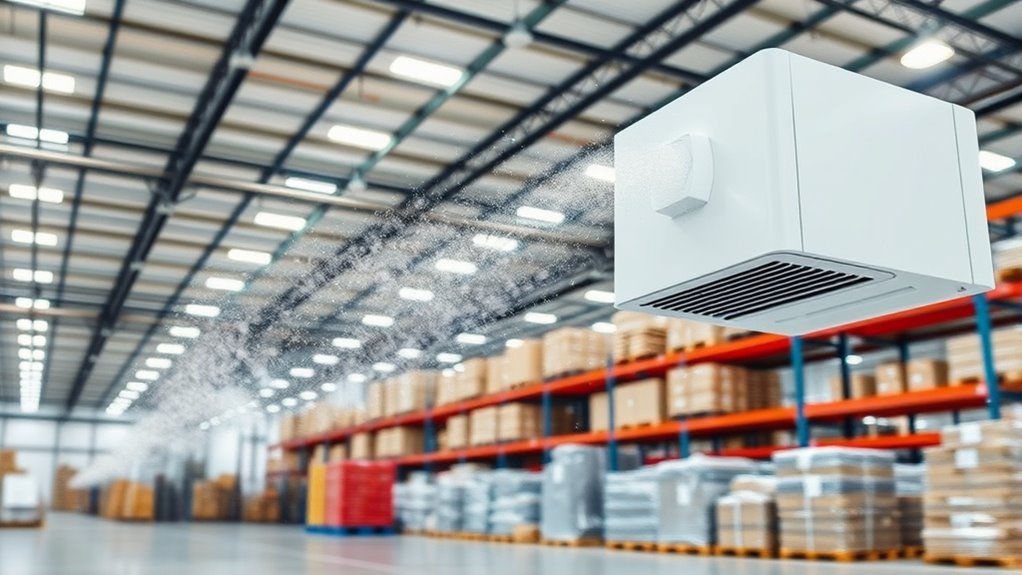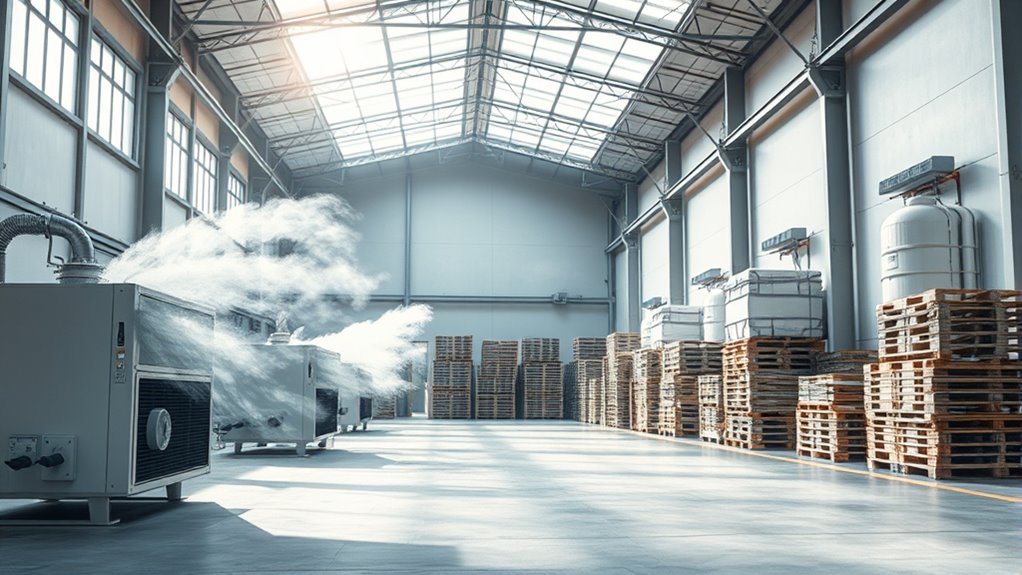To improve your warehouse air quality, focus on dust control and effective filtration strategies. Enclose storage to contain dust, use wet suppression, and implement regular cleaning with HEPA-equipped vacuums. Install high-quality air filters, including portable units, and guarantee proper airflow through ventilation systems to dilute airborne particles. Educate your staff on safety practices, including proper equipment use and mask protocols. Keep up with these measures to create a safer, cleaner environment—more tips await you below.
Key Takeaways
- Implement source containment methods like enclosed storage and wet suppression to prevent dust from becoming airborne.
- Install industrial air filtration systems with HEPA filters and maintain them regularly for optimal dust removal.
- Enhance ventilation with exhaust fans and natural airflow to dilute airborne dust and improve air quality.
- Schedule routine cleaning using HEPA-equipped vacuums to remove settled dust before it becomes airborne.
- Educate employees on dust control protocols and promote the use of protective masks to support a safety-focused environment.

Maintaining good air quality in warehouses is essential for ensuring a safe and healthy environment for workers. Dust particles from materials like cement, wood, or stored goods can quickly accumulate, leading to poor air quality that affects health and safety. To combat this, implementing effective dust mitigation strategies is crucial. You should focus on reducing dust at its source, such as using enclosed storage to contain particles or applying wet suppression methods that prevent dust from becoming airborne. Regular cleaning schedules are vital, too, as they help remove settled dust before it becomes airborne again. Using industrial vacuums with HEPA filters ensures that dust is captured efficiently without recirculating it into the air. Incorporating dust mitigation techniques not only improves air quality but also minimizes slip hazards and equipment malfunctions caused by dust buildup. Additionally, integrating automation technologies can help monitor dust levels more consistently and alert staff to areas needing attention.
Effective dust mitigation at the source ensures a safer, healthier warehouse environment.
Alongside dust mitigation, air purification plays a vital role in maintaining a healthy warehouse environment. You can install high-quality air filtration systems designed specifically for industrial settings. These systems continuously pull in air and filter out harmful particles, including dust, allergens, and other airborne contaminants. HEPA filters are particularly effective at capturing very fine particles, improving indoor air quality significantly. For larger warehouses, consider using portable air purifiers in high-traffic areas or zones where dust levels tend to be the highest. Proper placement of these units ensures optimal airflow and filtration efficiency. Additionally, maintaining the filtration systems regularly is key—changing filters according to manufacturer recommendations prevents reduced performance and guarantees ongoing air quality improvements.
To maximize air purification efforts, you should also focus on proper ventilation. Adequate airflow helps dilute airborne dust and contaminants, preventing their accumulation. Installing exhaust fans or increasing natural ventilation through windows and vents can greatly improve air exchange rates. When combined with dust mitigation and air purification, proper ventilation creates a cleaner, safer environment, reducing health risks for employees and decreasing equipment maintenance costs.
Finally, educating your team about best practices in dust control and air quality management is essential. Encourage workers to wear masks when handling dusty materials and to follow protocols for cleaning and equipment operation. Regular training ensures everyone understands the importance of dust mitigation and air purification measures, leading to consistent implementation. When dust is controlled effectively and air is kept clean through filtration and ventilation, you foster a safer workspace. This proactive approach not only boosts employee health but also enhances overall productivity and compliance with safety standards.
Frequently Asked Questions
How Often Should Air Filtration Systems Be Inspected and Maintained?
You should inspect and maintain your air filtration systems at least every three to six months, depending on your warehouse’s dust levels and usage. Regular filtration maintenance ensures peak performance and air quality. Follow your system’s inspection schedules, and replace filters as recommended by the manufacturer. Staying proactive with inspections helps prevent airflow issues and keeps dust and pollutants under control, creating a safer, healthier environment for your staff.
Are There Specific Regulations for Dust Levels in Warehouses?
Yes, there are industry standards and regulations for dust levels in warehouses. You should follow OSHA and local environmental agency requirements to guarantee regulatory compliance. These standards specify permissible dust concentrations to protect worker health and safety. Regular monitoring and testing help you stay compliant, and implementing proper dust control measures ensures your warehouse meets these guidelines, minimizing health risks and avoiding penalties.
What Are the Health Risks of Poor Warehouse Air Quality?
Imagine breathing in a cloud of dust that lingers like fog, slowly infiltrating your lungs. Poor warehouse air quality poses serious health hazards, including respiratory issues like asthma and bronchitis. Over time, exposure can weaken your immune system and cause long-term damage. You might notice constant coughing, shortness of breath, or chest tightness. Protect yourself by ensuring proper dust control and filtration to reduce these risks and maintain a healthier work environment.
Can Dust Control Improve Overall Warehouse Productivity?
Yes, dust control can boost your warehouse productivity. By implementing dust reduction strategies and enhancing air circulation, you create a cleaner environment that minimizes health risks and equipment downtime. Improved air quality reduces worker fatigue and discomfort, allowing your team to work more efficiently. Additionally, better air circulation helps distribute dust particles evenly, preventing buildup and maintaining a safer, more productive workspace.
What Are Cost-Effective Methods for Small Warehouses to Improve Air Quality?
You can substantially improve your warehouse air quality with cost-effective filtration and DIY dust control methods. Studies show that poor air quality can reduce productivity by up to 15%. To save costs, consider using affordable air purifiers or air filters, and implement simple DIY dust control solutions like sealing leaks and using damp cloths for cleanup. These small steps can make a big difference without breaking your budget.
Conclusion
By prioritizing dust control and filtration, you create a healthier, more inviting workspace that nurtures your team’s well-being. When you invest in clean air, you’re not just reducing dust—you’re fostering a safer environment where everyone can thrive. Every small step you take brightens the future of your warehouse, making it a place where productivity and comfort go hand in hand. Your care transforms the air, inspiring confidence and peace of mind for all.









